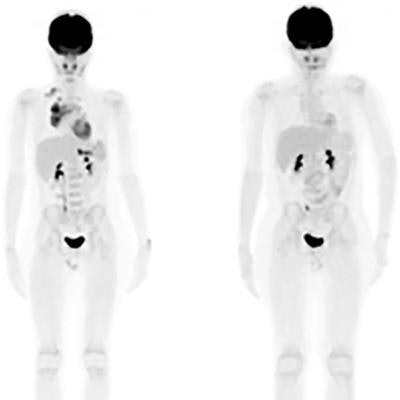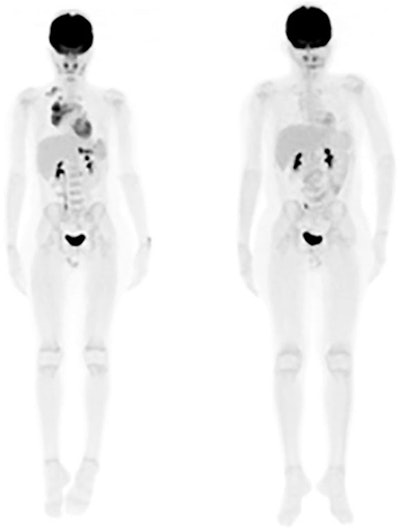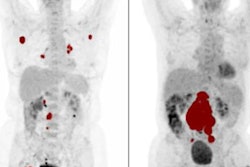
A routine "eyes to thighs" field-of-view with FDG-PET/CT scans is more than adequate to stage and monitor disease in a majority of pediatric patients with lymphoma, according to a study published in the August issue of the Journal of Nuclear Medicine.
An 11-country, multicenter investigation found that a true whole-body FDG-PET/CT scan, which images from the top of the head to the toes, detected lesions beyond a standard field-of-view in only 8% of young patients. Even then, the discovery of distant lesions did not change the clinical stage of any patient and did not alter any treatment plans.
"Our results demonstrate that the identification of additional lesions outside the regular field-of-view (eyes to thighs) [with] F-18 FDG PET/CT has no impact in the definition of the clinical stage of disease and minimal impact in the conduct definition of patients with pediatric lymphoma," wrote the researchers led by Dr. Juliano Cerci, PhD, from Quanta Diagnóstico Nuclear in Curitiba, Brazil. "As so, regular field-of-view for both staging and interim F-18 FDG PET/CT scans could be performed."
FDG-PET/CT has long been utilized to stage solid tumors in both adult and pediatric patients. While the approach in adults has been to limit scan coverage to the neck, chest, abdomen, pelvis, and upper thighs, pediatric oncology guidelines recommend a whole-body, head-to-toe approach since lymphoma could spread to a child's extremities.
With more anatomical coverage, however, comes concern about the additional radiation exposure to these younger patients, who could face multiple FDG-PET/CT cancer assessments during their development years.
So, why not go with a standard FDG-PET/CT field-of-view strategy, which means shorter scan time, less risk of patient movement, and fewer minutes under anesthesia? Is there a clear clinical benefit to a true whole-body scan?
Cerci and colleagues put that question to the test with a total of 305 pediatric patients (age range, 0.4-18 years) with newly diagnosed Hodgkin's lymphoma or non-Hodgkin's lymphoma who underwent whole-body staging and interim FDG-PET/CT scans from the top of the skull to their toes. A panel of 11 certified nuclear medicine physicians reviewed all 610 staging PET and interim PET scans (JNM, August 2019, Vol. 60:8, pp. 1087-1093).
Their review found that whole-body field-of-view PET images used for staging confirmed the disease was limited to the regular field-of-view in 280 patients (92%), with no new lymphoma lesions beyond that grid. Of the other 25 patients (8%) in which disease was seen beyond the regular field-of-view, 23 cases (92%) involved the bone marrow, while one patient (4%) had the disease spread to soft tissue and one patient (4%) had evidence of skin cancer.
Results from interim PET scans were identical, with 280 patients (92%) also showing no signs of disease outside of the regular field-of-view and no new lymphoma lesions among the 25 patients with metastases.
 FDG-PET images are from a 12-year-old male diagnosed with clinical stage II non-Hodgkin's lymphoma. Staging PET image (left) shows no lymphoma lesions outside the regular field-of-view. Interim PET image (right) shows a complete metabolic response after two cycles of chemotherapy. Patient was disease-free at 12-month follow-up. Images courtesy of JNM.
FDG-PET images are from a 12-year-old male diagnosed with clinical stage II non-Hodgkin's lymphoma. Staging PET image (left) shows no lymphoma lesions outside the regular field-of-view. Interim PET image (right) shows a complete metabolic response after two cycles of chemotherapy. Patient was disease-free at 12-month follow-up. Images courtesy of JNM."Our evidence reinforces that regular field-of-view PET/CT is sufficient in pediatric lymphoma, both at staging and interim assessments," the researchers concluded, adding that the findings do not suggest a routine field-of-view approach is applicable to other pediatric tumors.
"Just as there are certain tumors in the adult population that have more propensities to involve the extremities, tumors such as sarcomas, neuroblastomas, and leukemias are well known to have systemic involvement, and true whole-body PET/CT imaging is still the recommendation in children who may present with these and other tumors, even though there are limited data to support this approach," Cerci and colleagues noted.




















